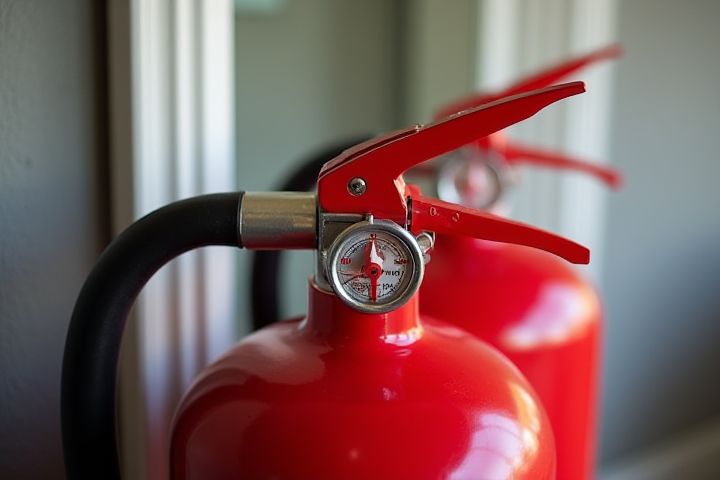
House fire extinguishers should be strategically installed in accessible locations throughout your home. Place units in high-traffic areas, such as the kitchen, where most fires may occur, ensuring they are near exits for easy access during emergencies. It's advisable to have extinguishers on each floor, including basements and garages, to cover all potential fire hazards. Consider mounting extinguishers on walls at a height that is reachable for all family members, generally 3 to 5 feet from the ground. Regularly check and maintain your fire extinguishers to ensure they are fully charged and operational when needed.
Where To Install House Fire Extinguishers
Kitchen
Install a fire extinguisher in your kitchen within 30 feet of any cooking appliances, as this is where most kitchen fires start. Choose a wall-mounted location, ideally 3 to 5 feet above the ground for easy access during an emergency. Ensure the fire extinguisher is easily visible and unobstructed by cabinets or clutter, promoting quick use. Regularly check the pressure gauge and expiration date to maintain its effectiveness, as a functioning extinguisher can be vital in containing a small fire and preventing escalation.
Garage
Install fire extinguishers in your garage at least 3 to 5 feet high on a wall, ensuring they are easily accessible. Consider placing one near the entry point of the garage, which allows for quick access during an emergency. Make sure to choose a Class B extinguisher suitable for flammable liquids, particularly if you store gasoline or oil. Regularly check and maintain your fire extinguisher, ensuring it remains fully charged and within easy reach for optimal safety.
Near Bedroom Exits
Installing house fire extinguishers near bedroom exits is crucial for quick access during emergencies. Ideally, place them within 30 feet of sleeping areas, ensuring you and your family can reach them swiftly if a fire breaks out. Make sure to mount extinguishers at a height of 3 to 5 feet, allowing all household members to operate them easily. Regularly check and maintain these extinguishers, confirming they are fully charged and have not expired, to ensure your safety.
Hallways
Installing fire extinguishers in hallways is crucial for accessibility during emergencies. Place them within 75 feet of any point in the hallway, ensuring they are in clear view and not obstructed. Choose locations near exits or at the intersection of hallways for maximum advantage, ideally at least 4 to 5 feet above the floor. Regularly check that your extinguishers are in working order and provide easy access for everyone in your home.
Near Electrical Panels
Installing house fire extinguishers near electrical panels is crucial for safety, as these areas are susceptible to electrical fires. Position your extinguishers within easy access, ideally within five to ten feet of the electrical panel, ensuring they are unobstructed and clearly visible. Select a Class C fire extinguisher, specifically designed for electrical fires, to effectively combat flames caused by electrical malfunctions. Regularly inspect and maintain these extinguishers to ensure they are fully charged and functional in case of an emergency.
Home Workshops
Install fire extinguishers in your home workshop near potential fire hazards, such as workbenches and heavy machinery. Position them within 30 feet of any flammable materials, such as paint, solvents, or wood shavings, ensuring they are easily accessible during an emergency. Wall-mounted brackets should keep extinguishers at a height of 3 to 5 feet, allowing quick retrieval. Regularly inspect your extinguishers monthly and consider placing a sign or label indicating their location for easy identification.
Basement Stairways
Installing fire extinguishers in basement stairways enhances safety during emergencies. Position one at the top of the stairs, approximately 3-5 feet off the ground for easy accessibility. Place another extinguisher at the bottom of the stairs, ensuring visibility and quick access from any direction. Make sure both extinguishers are mounted away from heat sources and easily identifiable, ideally within 75 feet of any potentially hazardous area.
Laundry Room
Install fire extinguishers in your laundry room at least 3 feet above the floor for easy access. Ensure the extinguisher is mounted on a wall near the entrance, allowing for a quick reach during emergencies. Choose a suitable extinguisher, such as a Class B for flammable liquids, which is important for laundry detergents and other household chemicals. Regularly check the extinguisher's pressure gauge to ensure it's in working condition, aiming for a replacement every 5 to 12 years based on the manufacturer's recommendations.
Outdoor Grilling Area
Installing fire extinguishers in your outdoor grilling area is essential for safety and quick response. Position a multi-purpose extinguisher (Class ABC) within easy reach, ideally no more than 10 feet from the grill, ensuring it is unobstructed and clearly visible. Ensure the extinguisher is mounted on a sturdy wall or post, away from direct exposure to heat and flames. Regularly inspect the unit for pressure and functionality, and educate your household members on locating and using it effectively.
Main Entrance
Installing a fire extinguisher near the main entrance of your home is crucial, as it provides immediate access during emergencies. Position it within 30 feet of the exit, ensuring that it's visible and unobstructed and that you can easily reach it even if there are flames. A height of 3 to 5 feet from the floor is ideal for easy retrieval, while also adhering to local fire codes that often specify placement regulations. Don't forget to regularly check your fire extinguisher's pressure gauge to confirm it is in working order, as a properly maintained unit is essential for effective fire control.
